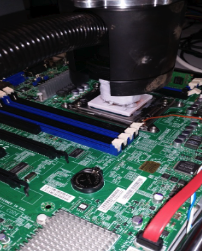Within the intricate tapestry of modern electronics, chipsets serve as the miniaturized maestros, orchestrating complex functionalities. However, like any diligent conductor, chipsets generate thermal energy during operation. This necessitates thermal validation, a rigorous process that safeguards the reliability and performance of these critical components across a vast temperature spectrum.
The Purpose of Thermal Validation: A Proactive Approach to Environmental Challenges
Thermal validation transcends mere temperature testing. It embodies a proactive strategy to mitigate potential malfunctions caused by environmental extremes. Engineers simulate the most demanding scenarios a device might encounter in real-world use by subjecting chipsets to a meticulously controlled range of temperatures, often exceeding expected operating conditions with a safety margin. This comprehensive approach ensures chipsets can function flawlessly, whether navigating the frigid Arctic tundra or enduring the scorching desert heat.
Beyond Chipsets: Ensuring System-Level Thermal Integrity
While chipsets are a focal point, the significance of thermal validation extends to a broader spectrum of electronic components. Processors, graphics processing units (GPUs), and memory modules all generate heat and require rigorous thermal evaluation. Validation ensures these components can effectively dissipate heat within the confines of the electronic device, preventing thermal throttling (performance reduction due to high temperatures) and premature failure.
End-Product Applications: From Mobile Devices to High-Performance Computing
Let’s illustrate the practical applications of thermal validation through specific examples:
- Smartphones: Consider a scenario where a user relies on their smartphone for navigation during a sweltering summer day. Thermal validation ensures the phone’s chipset, GPU, and cellular radio can efficiently manage the heat generated by processing power, GPS functionality, and cellular connectivity, guaranteeing uninterrupted operation and optimal battery life.
- Laptops: Laptops can generate significant heat when performing video editing or executing complex calculations. Thermal validation simulates demanding workloads, ensuring the laptop’s cooling system can effectively maintain the chipset, GPU, and other components within safe operating temperatures, thereby preventing performance throttling or unexpected shutdowns.
- Servers: In data centers brimming with servers, efficient thermal management is paramount. Thermal validation ensures server chipsets can withstand continuous operation and intensive processing demands without compromising data integrity or causing system crashes.
The Unseen Guardian of Electronic Stability
Thermal validation, though often an inconspicuous process, plays a critical role in our electronic devices’ unwavering reliability and performance. By meticulously testing components across a comprehensive temperature range, engineers safeguard these devices from the detrimental effects of environmental extremes. So, the next time you utilize your smartphone, laptop, or any electronic device with unwavering stability, remember the unseen guardian behind the scenes – thermal validation.

